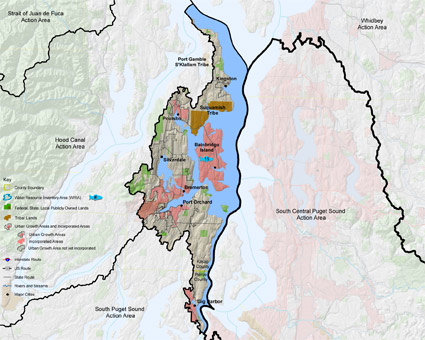North Central Puget Sound
 The western part of Puget Sound is distinct because of its many bluffs, estuaries, bays, harbors, and lagoons, containing over 220 miles of shoreline. Almost half of the nearshore habitat in Puget Sound’s central basin belongs to this action area, and the geoduck clam fisheries in the subtidal and intertidal regions of the West Sound rival the best in the world. High currents rush through Agate Passage, Rich Passage, and Port Washington Narrows. Chum, coho, steelhead, and cutthroat trout spawn in the 90 streams flowing into this action area. Pacific herring, surf smelt, and Pacific sand lance utilize the nearshore habitat as well, and commercial, recreational and tribal fisheries are active along the shorelines. Some sites in the West Sound, including Eagle Harbor, Dyes Inlet, and Sinclair Inlet, were contaminated by military testing materials and other chemicals, and are in various stages of remediation under the EPA’s superfund program.
The western part of Puget Sound is distinct because of its many bluffs, estuaries, bays, harbors, and lagoons, containing over 220 miles of shoreline. Almost half of the nearshore habitat in Puget Sound’s central basin belongs to this action area, and the geoduck clam fisheries in the subtidal and intertidal regions of the West Sound rival the best in the world. High currents rush through Agate Passage, Rich Passage, and Port Washington Narrows. Chum, coho, steelhead, and cutthroat trout spawn in the 90 streams flowing into this action area. Pacific herring, surf smelt, and Pacific sand lance utilize the nearshore habitat as well, and commercial, recreational and tribal fisheries are active along the shorelines. Some sites in the West Sound, including Eagle Harbor, Dyes Inlet, and Sinclair Inlet, were contaminated by military testing materials and other chemicals, and are in various stages of remediation under the EPA’s superfund program.
Many residents live outside of cities, which often results in loss of forestland and increased development that fragments existing habitat. In the next twenty years, the population is expected to grow by 100,000. It is particularly important to protect aquifers in this action area, since there is no snow fed water source. Stormwater runoff is another crucial focus. Pathogens carried in stormwater have led to closure of several West Sound shellfish beds.





